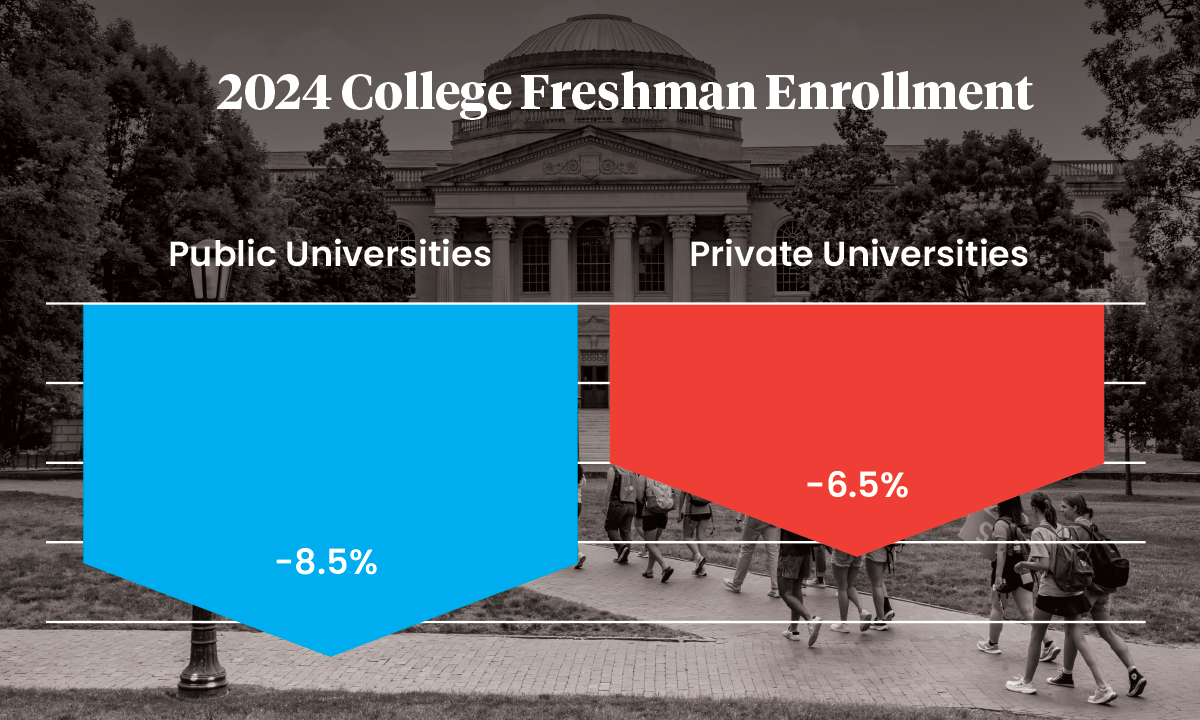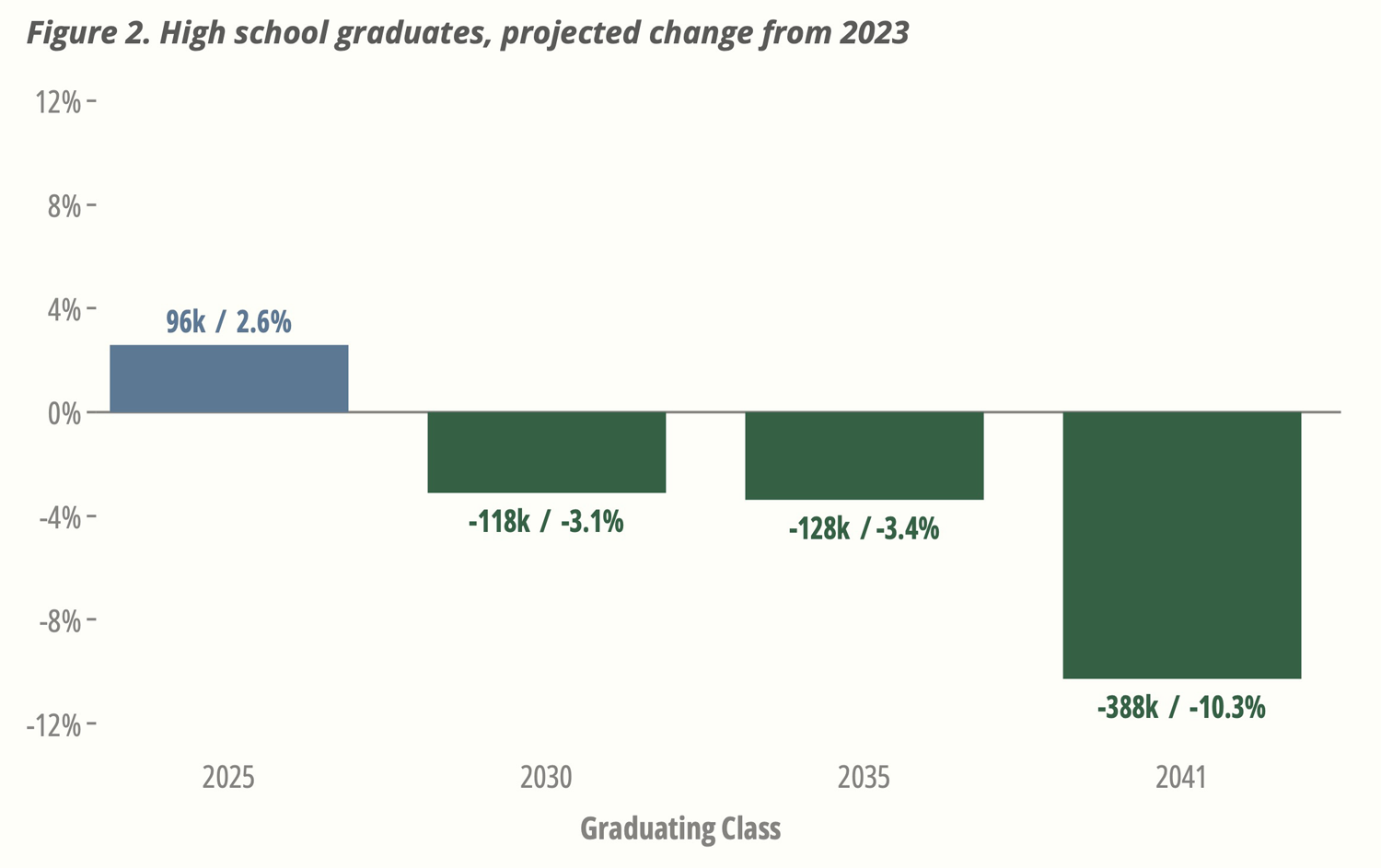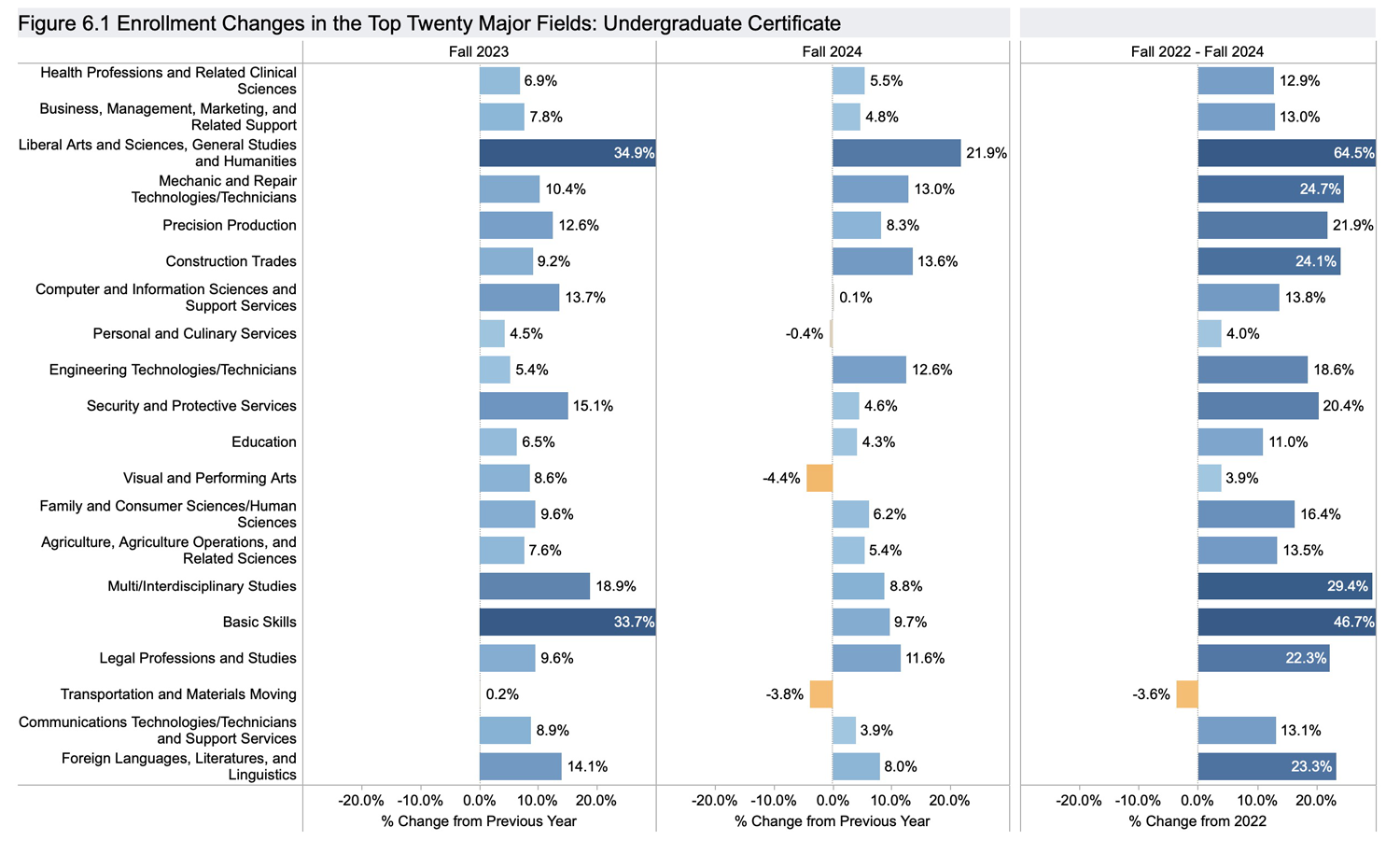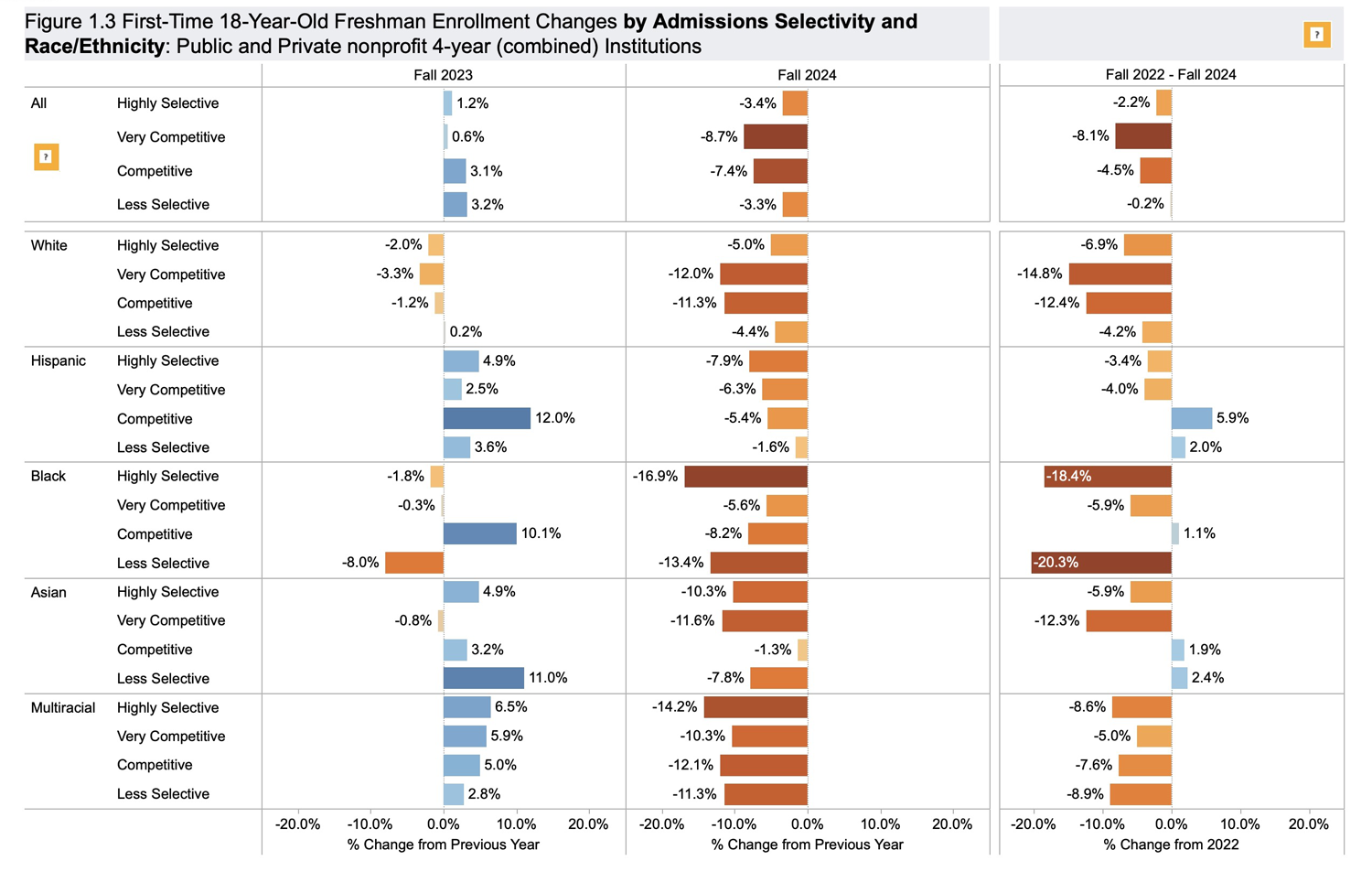Number of Freshmen Enrolling in Undergraduate Programs Sees Notable Decline
Overall undergraduate enrollments are growing steadily, though freshman numbers fall below 2023 levels.

Get stories like this delivered straight to your inbox. Sign up for The 74 Newsletter
Editor’s Note: On January 13, 2025, the National Student Clearinghouse Research Center announced that there had been significant errors regarding the freshman enrollment data they published in the Stay Informed report as well as the Special Analysis of 18-year-old Freshmen report in fall 2024. The organization cited an error in its research methodology and stated that freshman enrollment had actually increased in fall 2024. The center issued a corrected term enrollment report on Jan. 23. You can read our follow-up story here.
Key takeaways from a recent report underscore challenges facing the higher education sector including the economic concerns, practical realities and demographic shifts that have seen a notable decline in the number of freshmen enrolling in undergraduate programs.
Preliminary undergraduate enrollment figures for fall 2024 show enrollment increases for traditional-aged undergraduate students from all income levels, with gains of 3% over 2023 and growth in all sectors. Both undergraduate and graduate enrollments are increasing across all credential types, with bachelor’s and associate degree enrollment increasing 1.9% and 4.3% respectively, building on gains from fall 2023. The number of students pursuing undergraduate certificate programs has also increased, continuing to build upon these programs’ multiyear advances.
Freshman enrollment is a different story.
According to the report, which was released in October by the National Student Clearinghouse Research Center (NSCRC), total freshman enrollment was down 5% last year, reversing the 3.7% gain reported in fall 2023. Public and private nonprofit four-year institutions are seeing the largest decreases, down 8.5% and 6.5% respectively. Freshman enrollment is declining across all neighborhood income levels, with those from middle income neighborhoods seeing the biggest drop — a roughly 5% decline — at public and private four-year institutions.
The NSCRC began publishing higher education enrollment updates in the summer of 2020 to help policymakers and education leaders understand the effects of the COVID-19 pandemic on postsecondary enrollments. The report is updated within the first two months of each fall term to provide timely enrollment statistics, with a report published every January providing final fall term enrollment estimates.
The fall 2024 report was the first to break out data for colleges that serve low-income students, as indicated by the percentage of undergraduate students awarded Pell Grants at the institution. The new measure shows a significant decline in freshman enrollment at four-year colleges that serve lower income students, where these numbers have dropped by more than 10%, while enrollment in community colleges serving these students saw an increase of 1.2%.

The fall report was also the first to highlight 18-year-old freshmen — the students most likely to have enrolled immediately after high school graduation — as a distinct subgroup. The report revealed that this population’s enrollment is declining across the board.

Freshman Enrollment Headwinds
Jeremy Cohen, an NSCRC research associate and one of the report’s authors, said a number of factors are affecting freshman enrollment numbers.
“We can’t tell you how much of each headwind is the driving force behind each trend, but we can point to some factors that may be influencing some of the declines,” Cohen said in an interview. “One of the longer-term headwinds has to do with the demographic shifts in the country. We’re not quite to the point where the size of the high school graduating class is declining, but that’s expected to hit after 2025. There are also changes in the race and ethnicity composition of college-going students.”
According to a new report published by the Western Interstate Commission for Higher Education, 2025 will be the year when the metaphorical “demographic cliff” that has been the source of much higher ed consternation becomes a reality. The number of 18-year-old high school graduates will peak in 2025 at around 3.9 million and will be followed by a 15-year decline, according to the report.

“The other long-term factor affecting freshman enrollments is a cultural questioning about the value of a traditional four-year college degree,” Cohen said. “In this report, we’ve seen that enrollment in bachelor’s degrees for all undergraduates is growing the slowest, followed by associate degree programs, and the largest growth is in undergraduate certificate programs, which tend to be shorter-term, more trade- and vocational-oriented and are perceived to have closer connections to the job market.”
Enrollment in undergraduate certificate and graduate certificate programs have grown 19.1% and 13% respectively since 2022, compared with 2.9% for bachelor’s programs and 2.7% for master’s programs over that period.
Preliminary data in the Fall 2024 NSCRC report shows strong growth in mechanic and repair technologies/technician programs at both the undergraduate certificate and associate degree levels. Undergraduate certificate programs in construction trades and engineering technologies are similarly robust. Enrollment in programs focused on health professions and related clinical sciences programs is growing at both the associate and bachelor’s levels, while multi/interdisciplinary studies, engineering and social sciences are seeing gains at the associate degree level.

Another headwind that may have slowed fall 2024 enrollment figures is the rocky rollout of the “simplified” Free Application for Federal Student Aid (FAFSA) that prospective students fill out to determine their eligibility for financial aid.
For the 2024-25 award year the U.S. Department of Education made substantial changes to the form’s need analysis formulas and calculation of Federal Pell Grant awards. Though the aim was for the new FAFSA to be simplified and faster, the rollout was plagued by issues including a delayed release, a math glitch that failed to adjust families’ incomes for inflation, and technical issues with the form itself. Higher education experts, lawmakers and advocates worried that the botched launch might lead to a precipitous drop in enrollments for the 2024-25 school year.
Cohen said questions remain about what effect the delays and uncertainties about 2024’s FAFSA applications may have had.
“We can’t tell for certain that this added to the decline in freshmen because there are all these other things going on. But it is a factor on the table,” he said.
The Demographic Conundrum
At highly selective institutions, enrollments for 18-year-old freshmen who identify as Black, multiracial and Asian declined by much larger margins than white and Hispanic students in the fall of 2024.

Cohen said the decrease in enrollments among the most selective institutions may be related to the Supreme Court’s decision striking down affirmative action programs in college admissions. But that isn’t the entire story, he added.
The 2024 report saw a continuation of the trend of students declining to report their gender, race or ethnicity, which skews researchers’ ability to pinpoint all the factors at play. Nevertheless, Cohen said that the available data on 18-year-old freshmen at all institutions indicates significant declines in white students’ enrollment compared with that of other races or ethnicities.

Combining all undergraduate and graduate enrollments, Hispanic, Black, Asian and multiracial students saw strong growth, but enrollment of white students continued to decline.

“White students are a demographic group that is already declining in the high school population,” he said. “But these declines are certainly at a steeper level than those of the overall population.” Some of the decline in white freshman enrollments could be explained by the increase in students declining to report their race, but that can’t account for all of the decline.
“Any way you cut it, there’s a large decline in white freshmen that appears to be larger than their decline in the high school graduate population.”
Cohen stresses that the Fall 2024 NSCRC report and the special report on 18-year-old freshmen are preliminary analyses, with updates to be released later this month.
Get stories like these delivered straight to your inbox. Sign up for The 74 Newsletter

;)
